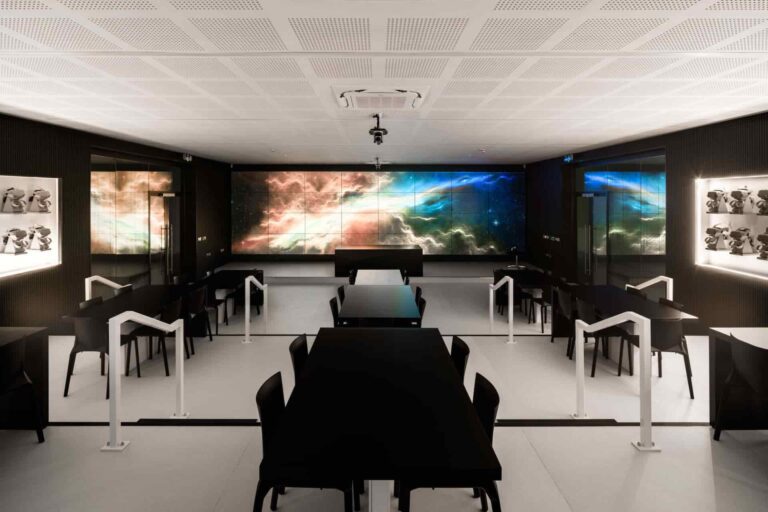
With leaps forward in AI, machine learning, and the coming age of quantum computing, any given school’s physical infrastructure needs to evolve by accommodating modern technology. For education and commercial training environments to be effective, buildings and interior spaces must fuel the desire to learn and fit the practical needs of the teachers, students, and community.
All of these principles factored into the architecture and design of Eastern Colleges Group’s Extended Reality Lab (XR Lab). Designed by my architecture studio, Windsor Patania’s, it was our most ambitious project yet. Here’s what we learned.
The Courtship
Eastern Colleges Group approached us to design and deliver the XR Lab, a building within a building, or hangar, at West Suffolk College, UK.
The space was designed with four distinct areas: an immersion lab, a collaboration theatre, a green room, and a conference room. The project combines augmented reality (AR), virtual reality (VR), and mixed reality (MR), often referenced collectively as extended reality (XR).
The Design
As working architects delivering on tech-focused projects, it’s critical that the buildings we design become a defined visual representation of the project brief. Setting the scene from the onset, XR Lab’s exterior is finished with a high-spec polished plaster, resulting in an enigmatic sci-fi presence. This unique appearance is further enhanced by a 3D triangular mesh that creates a visual connection with virtual environments, resulting in a captivating and futuristic design that complements the innovative technology inside the XR Lab. The XR facility includes 2 HTC VIVE headsets, 60 Meta Quest 2 headsets, a Virtuix VR treadmill, Teslasuit haptic suit and gloves, HaptX haptic glove, Optitrack motion capture systems, and wall-to-wall Samsung screens for student engagement.

A Contemporary Makeover
The XR Lab finds its home in Hangar 2, one of the 5 hangars of the 7200 square-meter STEM complex. This space was previously used as a workshop by engineering students. To foster energy-saving measures and to minimize the deployment of construction material, a pod-shaped design was chosen over utilizing the entire hangar space. The main benefit derived from the ability to contain thermal insulation solely to the size of the pod, which was in this way considered to be the primary thermal envelope, thus avoiding the need to thermally insulate and thermally regulate the entire hangar. Prior to the retrofitting, the building presented an outdated, light grey finish, and a large opening blocked by a roller shutter. Through extensive renovation efforts, the roller shutter was removed and replaced with a curtain wall to enhance the ingress of natural light into the hangar. The lesson: emerging tech and sustainable efforts should sit hand in hand.
A Dynamic Student Hub
The area surrounding the XR Lab boasts a versatile space, serving as a dynamic hub for students. Not only does it function as an exhibition gallery, but it also provides ample space for ‘real life’ social interactions and serves as a breakout area for students. The glass walls and open doors of the pod provide a window into the activities occurring inside, promoting collaboration opportunities. Events catered to varying age groups further enhance the space’s versatility, providing unique experiences for all. This dynamic environment fosters teamwork and social interaction, making it a vibrant and essential component of the STEM complex.

Project Reflections
Completed in late 2022 and recently opened to students, the most prominent feedback consistently references how the building design connects to its purpose. XR Lab’s architecture embodies the function of the building, creating a connection with virtual environments while inspiring the next generation of students. This was our biggest goal.
There is growing and widespread adoption of XR technologies across all industries, and beyond training for students. For commercial purposes, for example, vehicle manufacturers now integrate XR into product development to better understand how a car will look and drive. Ideas and concepts can now be evaluated thoroughly before a decision is made to invest in manufacturing equipment and processes. This reduces R&D expenditure and speeds up production time.
To take advantage of this emerging technology, commercial enterprises require sufficient computing power and suitable infrastructure to fully exploit high tech in real-world environments.
 Giovanni Patania is Co-founder of architectural firm Windsor Patania.
Giovanni Patania is Co-founder of architectural firm Windsor Patania.






